More than 1.5 million people informed through an earthquake preparedness campaign titled “Bogotá on Solid Ground”
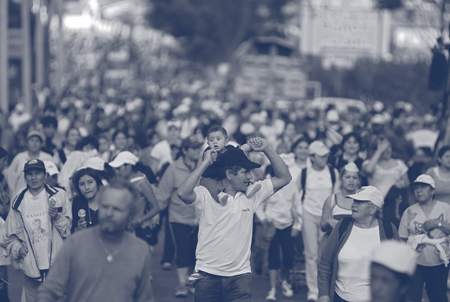
Photo: © IFRC
More than 300,000 people have participated directly, and 1.5 million indirectly, in the informative sessions of this educational campaign designed to prepare various groups of the population for the possibility of an earthquake in the Bogotá area.
A campaign that combines a dissemination process through the media with direct training in neighborhoods, businesses, and educational facilities. To date, this campaign is the largest of its kind in Latin America.
With a goal of reaching every community, Bogotá is at the forefront in the first and largest earthquake preparedness project of this kind in Latin America.
A media campaign and informational sessions on what to do before, during, and after a seismic event has equipped around 1.5 million residents of the capital city with basic information about how to act should an earthquake occur.
“Bogota on solid ground” [“Bogota con los pies en la tierra”] is a project that began 14 months ago under the leadership of the Bureau for Emergency Response and Prevention, part of the Government Secretariat, and the Bogotá Mayor’s Office.
So far, 4,000 awareness-raising sessions have been held in 832 neighborhoods, in the 20 local districts of Bogotá, as well as in 482 schools, 1,088 residential complexes, 1,007 businesses, 93 universities and technical/technological institutions, 432 government offices, 172 daycare centers, and 89 religious communities, among others.
Broad coverage
This is the first time that a risk management project has had such broad coverage in a Latin American city. Communities are requesting and receiving information, and are showing a great desire to learn by doing.
The program provides essential basic information through seis jugadas maestras [“six winning plays”] or six basic steps to prepare oneself ahead of time for an earthquake.
The workshops are held in neighborhoods, residential units, educational facilities (elementary and secondary schools and universities), and public and private enterprises (large, medium, and small). The workshops are led by a group of 25 promoters who were previously trained, and include more than 70 people at a time who gather to hold participatory and interactive sessions.
These awareness-raising sessions begin with a description of the current risk management plans in the city. The promoter, or trainer, and participants then discuss the structural problem related to the fact that 80 percent of Bogotá homes are not earthquake proof. Promoters also tell the community about the type of work institutions are already carrying out to prepare for a potential earthquake, and they invite all participants to take on joint responsibility towards that goal. Finally, the workshops provide information about and recommendations of what to do before, during, and after an earthquake at home, at work or at school. All these topics are covered in two and a half hours.
The Media campaign
The sessions have raised awareness and awakened the curiosity and interest of the residents of the Colombian capital. This work has been done hand in hand with a media information campaign that covers neighborhoods and districts throughout the entire city.
The media campaign includes activities on the radio, television, Internet, newspapers, and other printed materials. The target groups have been divided into three major groups: businesses, neighborhoods, and educational facilities.
The latter involves recreational activities, such as school contests and competitions. More than 400,000 students between the ages of 7 and 18 have participated in these activities.
In order to promote the project activities among children and youth, a cast of urban cartoon characters was created. The characters are led by a cartoon cockroach in what is called the “Prevention is Life” brigade.
A unique methodology
The purpose of this campaign is to provide neighborhoods, businesses and schools with the information they need to respond in a timely manner, protect and care for themselves in the event of a large earthquake in the city of Bogotá.
The hope is that these communities will create networks that replicate this information with their families, and in their neighborhoods and work environments. Impact studies have shown, in fact, that each person who attended the sessions has replicated the information with four or five other people.
A novel aspect of the methodology used has been the process of convening the communities to the meetings. Promoters do this directly in the neighborhoods, keeping three fundamental aspects in mind:
A. Through advertising: The sessions are advertised through the district and local media, and they are held directly in residential areas, educational facilities, and businesses of the different neighborhoods.
B. Chain reaction: It is the (joint) responsibility and commitment of everyone who attends these sessions to tell others about what they have learned. At a minimum, they should talk to their families about what they have learned, but they are also encouraged to spread the word in their social groups, work environments, and neighborhoods. Each participant also invites family members or friends to the next session being held in their area. This “chain reaction” technique is also used on the Internet in order to get information on risk management (related to earthquakes) out to a broader group of people.
C. Through neighborhoods: The presentations are made throughout the 20 districts of Bogotá, using a “sweep” method in order to reach the largest number of neighborhoods in each district. The promoters “take over” one local district a day and get to the largest number of neighborhoods possible in one week.
Why is this campaign so important?
Although it is possible that an earthquake occurs in Bogotá, citizens are not well prepared for such an event. To a large extent, this is due to the lack of awareness about the possibility that this could actually happen. Taking into account the general rejection generated when mentioning the likelihood of an earthquake (although it is impossible to predict it with total accuracy), it is important to demystify this phenomenon and learn that, through effective prevention measures, one can remain calm during and after such an event, and control any situation that may lead to panic attacks.
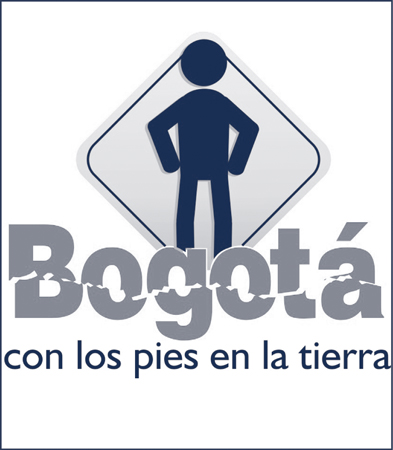
The metaphor of the game
Undoubtedly, panic plays an important role during these events. Earthquakes are perhaps the natural phenomena feared the most by the population, since it is virtually impossible for any place to be completely immune from them. In contrast to other events, such as hurricanes, people cannot react ahead of time. Based on this reality, awareness-raising activities must first aim at helping people isolate their fear.
As stated before, a seism cannot be predicted accurately, making it impossible to say exactly when and where an earthquake will take place, as well as all the consequences it will bring about. For this reason, when addressing this issue through the media, the first thing to take into consideration is that the message to be conveyed should not include any information that might create panic among the population. If this happens, it is very likely that the message will be rejected. Drawing on this element, the concept that we are proposing is to develop a visual language, which is primarily figurative. The first phase of our campaign is aimed at raising awareness among the different communities in Bogotá about the likelihood of an earthquake but, at the same time, it is intended to demystify, without trivializing, the impact of a potential seism, and to learn how to “live” with this ongoing risk.
The concept of games, and particularly board games, is the tool that we propose to create a dynamic, simple and universal language, away from any alarmist interpretation. This language will be used to present the first phase of this campaign.
By using dominoes, playing cards and chess, a number of messages are conveyed to remind citizens of the importance of being prepared for an earthquake.
Your life at stake
In addition to the language that will be developed for each of the campaign’s elements, the written material will be geared towards highlighting the value of risk prevention. With the phrase “Your life cannot be at stake…”—which is also the title of all the audiovisual materials developed for the campaign—we seek to create some expectations about the image and the meaning of the message, which also uses the phrase “An earthquake cannot be prevented, but you can be prepared.” This phrase openly expresses the importance of being alert and prepared for a large event or an emergency situation. The second phase of the campaign will include more specific recommendations related to coping with this natural phenomenon.
The logotype
With the purpose of positioning this campaign in the long run, an additional element was developed, so that the campaign could be identified through its logotype. The logo, to be included in all visual materials, will be made up of a pictogram similar to a warning sign that will show an individual standing inside a square that rests against its own vertex, which represents instability. The image will also include the word “Bogotá “written in Helvetica black, with a “fracture” visual effect to represent the potential structural consequences of a seism. The idea is to integrate both human and urban elements into this logotype, accompanied by the other phrase that is part of the campaign’s title: “con los pies en la tierra” (on solid ground). This phrase highlights the importance of being calm, serene and prudent. These three virtues are necessary when facing successfully such a difficult situation. Finally, the colors chosen are the ones used to identify the capital city (red and yellow), so that the campaign is recognized throughout the city.
The pieces… Dominoes
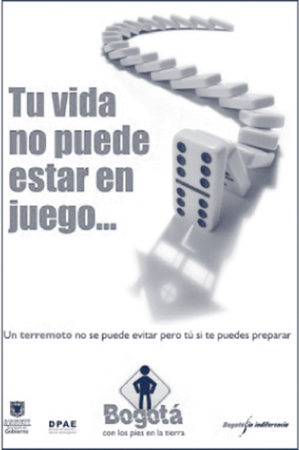
The first game used is dominoes. This simple game, which is well-known among different sectors of the population, will be used to explain that an earthquake is similar to a sequence of domino pieces which, with just a minor motion, one by one can generate a chain reaction, as described by the expression “domino effect.” This visual metaphor, represented by the urban environment, will help people better understand the context of a real seism.
As a game of chance, dominoes will also imply the unforeseen and random conditions of an earthquake, as well as its almost unpredictable and unanticipated consequences.
Chess
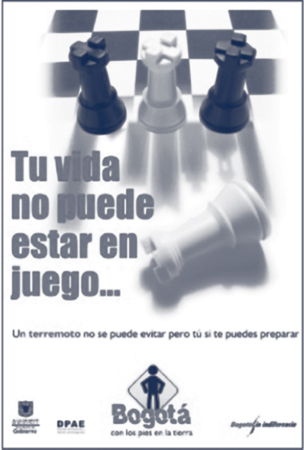
This millennial game, which is a little bit more elitist than dominoes, is characterized by the intelligence and the strategic vision of those who play it. The game will be used to approach higher-class segments of the population. The main image is composed of the four towers, and one of them collapsed on the board. This reflects our total vulnerability to earthquakes, regardless of our social or economic conditions. The image also highlights the importance of developing strategies before and after an earthquake, so that its effects and impacts are minimized in the context of prevention. People also need to learn to react promptly and intelligently to such an event.
Playing cards
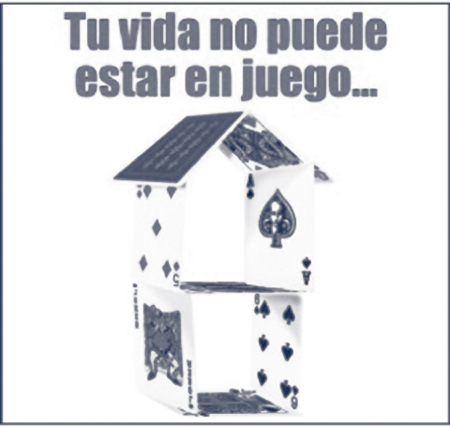
Although playing cards are not used in the specific context of board games (51, continental, poker), we used them to refer to the concept of a “house of cards.” This reflects the fragility of our urban environment to an earthquake. Similarly to dominoes, playing cards are recognized universally as a synonym for game of chance, good or bad, unforeseen and uncertain, without turning to magic. We used the French deck of cards because they are more common in our city and more related to board games than the Spanish deck of cards, since their use is more related to guessing games, which is far from what is accurate and scientific.
For further information, please contact:
DARIO SANCHEZ POSSO
Advisor and Coordinator
Bogotá con los pies en la tierra campaign
Bureau for Emergency Response and Prevention
Government Secretariat
Mayor’s Office, Bogotá
Telephone number: 4297414, extension 2835
Diagonal 47 · 77 -B- 07
Bogotá, Colombia
|
![]()